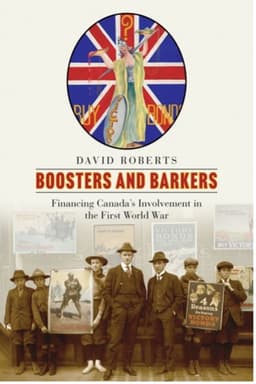
Book Review
Boosters and Barkers: Financing Canada’s Involvement in the First World War, 2024
By David Roberts
Buy the book: https://www.ubcpress.ca/boosters-and-barkers
In the business of war, business is often an unacknowledged partner. The imperative to finance the substantial costs of war is easy to overlook compared to the human and social costs of conflict, though it is no less a critical feature of wartime strategy. In Boosters and Barkers, David Roberts reveals the considerable efforts that went into financing Canada’s involvement in the First World War, often featuring novel strategies and partnerships between the Canadian government, the private sector, and individuals. As Roberts stresses throughout the book, it was never a sure outcome that the Borden government would be able to secure the money it needed to pay for Canada’s war effort. Before the outbreak of the war, the Canadian economy was in a depression and the federal government’s deficits had ballooned to unsustainable levels. Canada was, in short, fiscally unprepared to embark on the expensive engagement of war in 1914.
In this bleak context, the role of federal finance minister would appear to be an unenviable one. Roberts paints a compelling portrait of Thomas White, who served as Canada’s Minister of Finance between 1911 and 1919 and is the predominant figure throughout the book. White was an unlikely choice to become Borden’s first Finance Minister. He had previously supported the Liberal Party and was a businessman with no political experience and without a seat in Parliament when he was brought into the hefty finance portfolio. The pressure of managing the country’s finances in a dire fiscal position put a considerable personal strain on White, who, though a central member of cabinet, seemed to always remain a political outsider. As Roberts illustrates, White often appeared to act as a one-man show, the ultimate booster and barker reflected in the book’s title.
White’s business experience would prove to be a critical asset in his mission to find revenue streams to finance Canada’s unprecedented war effort. White often looked past his political counterparts to find collaboration on efforts to manage the country’s finances. He convened a committee composed of leaders from Canada’s major banks to devise what became the Finance Act, which took Canada off the gold standard and allowed the government to act as a lender of last resort. White’s 1915 budget speech, described by Prime Minister Borden as a “business statement,” laid the groundwork for significant new appropriations. As the war dragged on and the costs increased, White turned to new taxes on businesses and eventually an income tax.
It was the war loan campaigns, however, that proved to be the most novel and successful idea for generating revenue, ultimately raising over $6 billion and covering a substantial portion of the wartime costs. The efforts to sell the loans and the public response to them are the focus of much of Boosters and Barkers. Selling the loans became a novel kind of business because the concept of bonds was new to many Canadians. Campaign organizers led sophisticated sales campaigns, tailored to different communities and audiences, harnessing the power of advertising to great success - though not without attracting some resistance, as Roberts details in one chapter. The business of mass marketing boomed in the war and played a critical role in resolving Thomas White’s conundrum of raising the revenue needed to pay the financial costs.
Boosters and Barkers is an ambitious study with a wide lens that covers all of Canada and Newfoundland, including French and English sources, from the outset of the war to the 1920s. It is divided into five distinct sections. The first two parts are the most substantive, covering the federal government’s appropriation of wartime funding and the rolling out of war loan campaigns. Other sections examine the situation in Newfoundland, the critics of the financing efforts, and the war loan propaganda in Canadian society and culture.
The book is an important addition to the historiography of Canada and the First World War, providing a more complete picture of the fiscal realities in which the war effort was anchored. It is grounded in extensive research and provides impressive detail, though at times the reader is left wanting to step back and see the bigger picture of the information conveyed. The four-page conclusion is succinct but misses the occasion to reflect on the lasting legacies and wider reflections that the preceding 300 pages inspire. Nonetheless, the book illustrates how the cost of war is more than the battlefield casualties and societal scars it leaves behind. The carnage and desperation of war can seem so enormous as to be impervious to the comparative banality of balance sheets, but fiscal imperatives nevertheless stock the scene, even if often left out of the frame.
Peter Price
Ottawa, Ontario